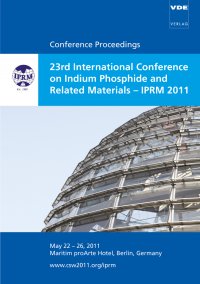FT-DLTS studies on deep levels in InAs quantum dashes grown on InP
Konferenz: IPRM 2011 - 23th International Conference on Indium Phosphide and Related Materials
22.05.2011 - 26.05.2011 in Berlin, Germany
Tagungsband: IPRM 2011
Seiten: 4Sprache: EnglischTyp: PDF
Persönliche VDE-Mitglieder erhalten auf diesen Artikel 10% Rabatt
Autoren:
Zouaoui, Mouna; Girard, Philippe; Bremond, Georges (Institut des Nanotechnologies de Lyon (INL UMR-5270), Université de Lyon, CNRS, INSA- Lyon, 7, Avenue Jean Capelle, Bât. Blaise Pascal, 69621 Villeurbanne, France)
Regreny, Philippe; Gendry, Michel (Institut des Nanotechnologies de Lyon (INL UMR-5270), Université de Lyon, CNRS, Ecole Centrale de Lyon, 36 avenue Guy de Collongue, 69134 Ecully, France)
Ajjel, Ridha (Laboratoire de Physique des Semiconducteurs et des Composants Electroniques, Département de Physique, Faculté des Sciences, 5019 Monastir, Tunisie)
Inhalt:
In this paper, we present a DLTS (Deep Level Transient Spectroscopy) study on InAs quantum dashes (QDas) grown by solid source molecular beam epitaxy on InP(001) substrates. These QDas are formed using the Stranski-Krastanow growth mode which undergoes from such strained epitaxy. The control of the growth conditions allows us to dispose of InAs QDas emitting at 1.55 µm. Isothermal capacitance/voltage (C-V-T) and transient capacitance spectroscopy measurements are performed to probe the temperature and electric-field dependence of the electron emission from charged QDas. Due to the high leakage current undergoing by the Schottky contact on the InP capped layer of our sample structure, only three energy levels have been found within the 10K-160K temperature range, at energies of 260 meV, 144 meV and 40 meV below the bottom edge of InP conduction band, respectively. This paper focuses on the study of the different mechanisms of emission process such as tunnelling mechanism and thermionic emission from the QDas confined states in order to identify the energy levels induced by these QDas.


